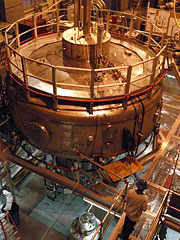Novel fusion device mimics the planets
Kesner, Mauel, and their team spent more than six years designing and building their novel experimental device, and in summer 2004, the LDX was ready for “concept exploration” experiments. Nuclear fusion was not the goal—at least not yet. At issue was simply how well the device’s magnetic field could confine plasma at rising pressures (a combination of temperature and density). As plasma heats up, it starts generating electrical currents that can undo the fields created by the magnet. “So the closer you get to conditions required for fusion, the more difficult it gets—the more ability the plasma has to defeat your confinement scheme,” Kesner explained.
Their confinement scheme performed well. The floating ring is not yet levitated but rather supported by several solid rods, which scrape off plasma. Even so, the plasma behaved as predicted. “With strong heating we got very substantial pressures, even with the losses going to the support rods,” said Kesner. And the electric current inside the ring kept flowing for hours at a time. An innovative insulation system maintained the ring’s low temperature even while plasma temperatures outside rose to hundreds of millions of degrees. “The results of our first experiments look very good, and it’s very exciting,” said Kesner.
Within the next few months, the team should be ready to remove the supports and perform the first levitated experiments—an important milestone, as the magnetic field lines will then circle the floating ring unimpeded. Results of those experiments will show whether this novel method of trapping hot plasma might one day be used to create a source of fusion power.


